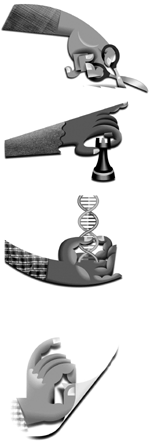 |
Left-handed
in a right-handed world You could call
it the quiet handicap: Most people don’t notice it, and those
who have it rarely mention it. But given the history of lefties,
it’s little wonder. “For centuries, and in many countries today, left-handedness has been like the negative sign in electricity ... the weaker side, the second best, indeed morally the evil side,” writes Michael Barsley in “A Social History of Left-Handedness.” “The prejudice pervades every sphere of life, and the more primitive and superstitious the environment, the greater the prejudice.” Satan himself has long been viewed as a lefty — perhaps the first. During the days of witch hunts, women were condemned as witches if they bore the “mark of the Satan,” that is, had moles or blemishes on their left side. People believed the devil marked his followers — using his left talon, of course — during fiendish ceremonies. This deeply rooted belief that our left side is wayward is so ancient, it’s even embedded in our language: In Latin, the word for left is “sinister;” in French, it’s “gauche.” And the English word “left” comes from the Anglo-Saxon word “lyft,” which means weak or broken. These days, we usually know better than to label all Southpaws as evil, though there are still lapses. A famous one occurred in 1978, when the Ayatollah Khomeini, a key player in crushing the Shah of Iran, claimed he could prove Allah had cursed the Shah. The proof: The Shah’s firstborn son was left-handed. Rather than a curse, however, modern researchers say being a lefty is actually a matter of brain development. And although scientists certainly don’t have all the answers, it does appear at least some people are hard-wired to be southpaws because of an early trauma. “The idea that the Devil is sinister, in hand use as well as in his other behaviors, has been institutionalized in many ways,” researcher and University of British Columbia psychology professor Stanley Coren says in his book, “The Left-Hander Syndrome.” Even the evil one’s name has connections to all things left: The Hebrew word for left, “se’mol,” is clearly associated with the Hebrew name for the devil, Samael, who sat on God’s left side, Coren says. In the Zohar, the Jewish book of mysticism, the name of the serpent that lured Eve into sin is likewise Sammael, another derivative of the Hebrew word for left. “We are even told,” Coren writes, “that this serpent Sammael represents the personification of evil, the other or left side.” Even as late as the 1950s, some elementary-school teachers persisted in trying to stop their young charges from being southpaws. (We get the term southpaw, by the way, from baseball. In an old Chicago ball park, the pitcher faced west, and therefore a left-handed pitching arm was south.) Scott Maddox, a southpaw and the mayor of Tallahassee, Fla., said his left-handed dad told him stories of having his left hand smacked with a ruler and tied to his body during attempts to make him right-handed. (It didn’t work.) And though no one tried to pull that on the mayor, he and others can still recall the problems they had as kindergartners, struggling to learn the fine art of snipping paper with right-handed scissors. Later, little left-handers have problems with messy writing. “You end up dragging your hand across what you’ve written,” says southpaw Scott Roberts, a 28-year-old musician and Cabos Tacos employee. That’s the reason some lefties hitch their arm up over their paper when writing, so they don’t smear the ink as their hand moves across the page. Given those and other types of daily living disadvantages - watching their left elbow to prevent collisions with right-handers when eating or taking lecture notes; needing special golf clubs and baseball mitts; learning to drive a stick-shift right-handed - it would seem that the easiest thing for a left-hander to do would be to become right-handed. And some do learn to do many things right-handed. But for many, it’s just not that easy to switch. The brain being the multi-faceted jewel that it is, still holds myriad secrets. But scientists have gathered some evidence to support several reasons for being left-handed. First, there is evidence that some lefties inherit their hand preference. There is also research that indicates that some are left-handed because of brain trauma during birth or in utero, perhaps when the fetal brain is developing distinct cerebral hemispheres. Multiple births also increase the chance of left-handedness: All that sibling poking and jabbing in utero.) Researchers have uncovered a strong correlation between a mother’s age and the rate of left-handedness: The older the mom, the more likely she’ll take home a lefty. ccording to Coren, if the mother is 40 or older, the likelihood of having a southpaw is 128 percent higher than if she had been in her early twenties. For southpaws who are left-handed as a result of extreme prenatal or birth trauma, there may occasionally be other difficulties as well. According to Coren, “among the mentally retarded, left-handers are two and a half times more common” and “an unusually large number of left-handers get into trouble with the law.” Also, as a group, some researchers have done studies that show lefties don’t live as long. On the other hand (and you knew that phrase would show up here somewhere, didn’t you?), there are lots of lefties who live long, healthy and productive lives — as the accompanying list of famous lefties attests. Some people also contend that left-handers are more original and creative as a result of their different brain wiring. And certainly there are plenty of lefty leaders: In 1992, voters had to elect a lefty for president — George Bush, Bill Clinton and Ross Perot are all southpaws. One of the most interesting tidbits researchers have unearthed is that humans appear to be unique in their species’ preference for being right-handed. While individual cats, dogs, apes, chimps and other creatures may show a preference for one paw or hand over another, nearly as many will prefer their left as their right. And for some animals, there may be an advantage to being ambidextrous. Animals need to be able to respond quickly when a predator — or prey — appears. To greatly favor one side over the other might cause them to lose a tasty dinner — or perhaps become one. The whole right vs. left debate, however, misses the entire point, according to some Greek philosophers. To them, the very preference of one hand or foot over the other — be it right or left — was evidence of human imperfection. Because in the beginning, according to Aristophanes, we were created as spherical beings. We had no front, no back, no left, no right. We were perfectly symmetrical. But — and here’s where the story starts sounding familiar — we perfect human spheres screwed up. We became so haughty and arrogant that Zeus got fed up with us and ripped us in half. He tossed our sorry parts to the god Apollo, who kindly fashioned our faces (and whatnot) to face forward in the hopes that maybe that would help us pay better attention to the gods. And while there’s no research on whether Apollo’s redesign has helped our attention, if the Greeks were correct, then one thing seems certain: Right- or left-handed, we’re all imperfect beings. Illustration by KRT Campus |
|
|
TCU Daily Skiff © 2002 |
||


